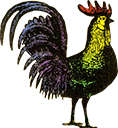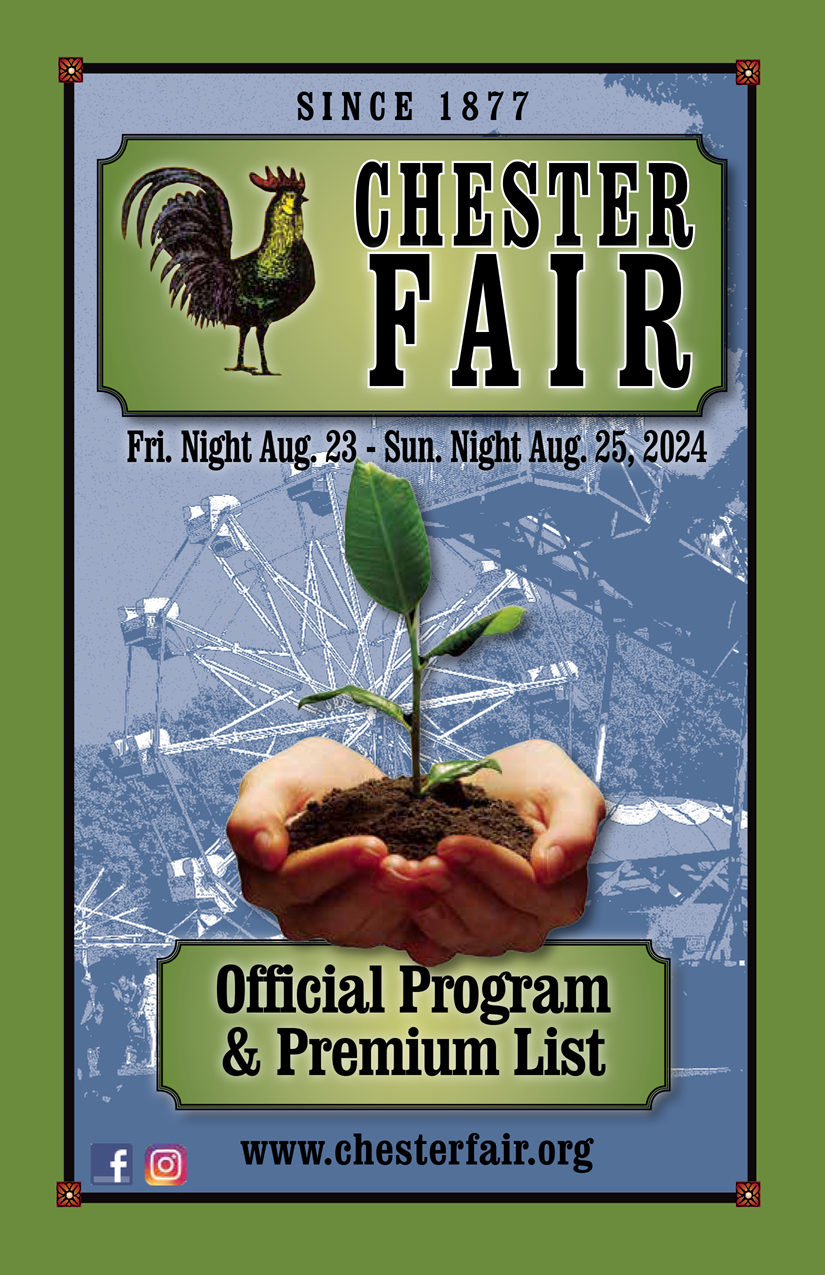This account of the History of the Chester Fair was taken from Kate Silliman’s Book “Chester Scrapbook” which was published by and can be purchased from the Chester Historical Society.
For many years “The Fair” has been an integral part of the life of the town. The older folks remember it as the time when friends and former neighbors returned; when old memories were revived and ties renewed; when children were introduced and admired; when friendly rivalries among farmers and farmer’s wives resulted in close contests on the field and in the exhibitions; when the youngsters competed for prizes of “hard cash.” A country fair offered much in the lives of both farmer and factory worker, and was eagerly looked forward to and long talked about. Chester Fair has always been a true “country fair.”
Sometime early in 1877 a group of men gathered to discuss forming some sort of society that could sponsor an exhibition of those two facets of Chester life most important to the town, farming and mechanics. Indeed, by this time, with its farms up on the hills and its little factories tucked away in the valleys, the attention of the residents was about evenly divided between the two. The intent of the newly formed Agricultural and Mechanical Society of Chester was “to promote and awaken an intelligent interest in Agricultural and Mechanical pursuits.” Officers were to be the usual president, vice-president, secretary, and treasurer, augmented by a Board of Directors of not less than seven nor more than ten persons.
The first fair was held in the fall of 1877. It was a small gathering, for the idea was a bit new. The directors and officers met often and considered ways to make it more interesting and appealing. Apparently the first fairs were free, but in August 1880, the officers, with Charles E. Lord as secretary, voted to hold the fair September 29 and 30 at Town Hall and charge 10 cents admission for each day. A notation was made in the record that the “executive committee is to arrange for victualling.” The membership fee was set at 25 cents, but it does not state whether this entitled a member to free admission to the fair.
The following year, with A. H. Gilbert as president, S. W. Clark as vice-president, C. E. Lord as secretary and treasurer, and only three on the executive committee, F. G. Clark, J. E. Watrous, and Robert Huxten, the Society first considered staging a parade. This eventually grew to be quite a feature of the fair, but it was discontinued about 1930.
Encouraged by the response to their efforts, the Society voted in 1882 that a premium of $1.00 be given for the heaviest hog killed in Chester before the close of the year. They also voted that members of the Society receive free admission to the fair. The following year a committee of three was appointed to find some sort of amusements to interest the crowd, and was empowered to offer prizes up to a value of $15.
A printed list of the classes of exhibits and the premiums offered was made each year, but not until May 1884 is there any mention in the old records of having a committee to solicit advertisements for this list. For these first few years, the fair did not do exceedingly well, nor badly enough to warrant closing it.
By 1887 the Society officers voted that special premiums might be offered to people outside the Society who wished to exhibit oxen, steers, calves, and horses; $35 was allocated for prizes. It would seem that up to this time membership in the Society was a requisite for exhibiting at the fair. With this new ruling on who could exhibit, it was voted that an entry fee of 75 cents be charged those bringing in exhibits.
Two years later the society voted “to consider the matter of outdoor sports,” so we assume that in September of that year they were incorporated as part of Fair Day.
The committee cannily voted that “J. Fred Medcalf be given the space for his organs provided he furnish a piano.” Music became a part of Fair Day, also, for the Lyme Band was hired ‘for $30 and their lunch” to play on September 24, 1889. Records go on to show that the following year the first of a series of evening entertainments was given to help defray the expenses of the fair. By the early 1900s these entertainments were a most important part of Fair Day, and much amateur talent worked long and hard to provide the plays that were given on the stage of the Town Hall. As that same stage had been occupied by some sort of exhibit all day, there was a frantic rush to clear it and restore the Hall to order before time for the old curtain to be rolled up.
Perhaps encouraged by the competition offered in various lines by the exhibitions at the fair, in 1891 a “Pumpkin Club” was organized among some of the gardeners in town. More in fun than anything else, a serious vein underlay its avowed purpose “to encourage the raising of large pumpkins for the next fair.” Each member of the club was to pay an entrance fee for his exhibit, and the amount thus collected would be divided into premiums for the three largest pumpkins. About fifty persons joined the club, and no doubt there were some gigantic pumpkins about which the membership could boast. The society got into the swing of the matter by voting $3.00 for the heaviest pumpkin, and $1.00 extra if the record is beaten.”
With pumpkins on the minds of the men, the Society voted that “the privileges of eating, confectionery, etc. be left for the Ladies Societies to bid for.” The Ladies Benevolent Society of the Congregational Church and the Ladies Aid Society of the Baptist Church thereupon vied with each other for the privilege of feeding the hungry fairgoers and perhaps putting a bit into the society treasury. In 1892 the Congregational ladies bid $10.25!
Bidding for various privileges thus established, it was voted that “the bands in Moodus, Hadlyme, Lyme, Saybrook and Westbrook be invited to send in bids for furnishing music at the fair.” To make the day even more interesting, a bicycle race was suggested, and the Society voted to offer “three prizes …for bicycle race by boys under 16 years of age, $3, $2 and $1,and the same for persons over that age.”
The fair of 1893 was not a success financially, or perhaps the Society had become too generous in offering prizes and premiums. They found there was not enough in the treasury to pay those premiums, so they voted to borrow $150 from the bank. Three years later, in December 1896, it was reported that the fair of that year, held on October 6 and 7, was a complete success,” exhibitions good and receipts satisfactory.”
So the fair developed. There were good years and bad. It was sometimes hard to find officers to serve the Society; it was often hard to pay the premiums. Certain things became features of the fair, without which it would not be complete. The parade that opened the first day attracted the attention of imaginative persons around town, and factories and societies entered floats. One of the highlights of the parade was “Uncle Carlos” Watrous and his whirligig. Every year he worked on a new design, which he proudly demonstrated at the parade. His intricate concoction of gears, wheels, flying arms, and twirling balls no doubt could have been the inspiration for one of Rube Goldberg’s creations! Bicycles were decorated, and the current band provided the martial music that led the parade through the town and up to the Green. The Town Hall there was used for the exhibits of grains, vegetables, flowers, and the domestic arts of the women. Long tents flanking the building held the fowl and small animals, while the cattle were kept in pens on the opposite side of the roads encircling the Green when various side shows and booths began to line the outer edges. A “Tug of War” was a great event in the early 1900’s and a silver cup was offered the winning team. If won in three consecutive years by the same team it might be kept, and great was the rivalry among the young men in town.
The Town Hall and the Green were not always large enough to properly exhibit the wares of the entrants nor to allow the crowds, and at various times other locations were tried. In 1903 Simeon Brooks’ Casino on East Liberty Street was used. The following year both the Town Hall and the Casino were used. In 1905 there was no Fair, but it was revived the following year, not to suspend again until the years of World War II. One year the Society tried Camp Hazen, but abandoned this site when a parachutist who was to have thrilled the crowd by an exhibition jump was killed.
After World War II, in 1946, the Chester Agricultural and Mechanical Society was reorganized and the fair date was changed to August. A new site for the fair was chosen; the Society purchased land from Eldon B. Kirtland on Middlesex Avenue. ( The current site of the Fair) In spite of a few head shakings among some of the older residents who said it was too far away, and there were no buildings or shade on the lot, this change proved successful. The first year over two thousand tickets were sold at the gate in addition to the several hundred membership tickets purchased beforehand.
The following year the fair was held on two days, as it had been often in the past, and it was a great success. Perhaps some of the “old country fair” atmosphere might have been lacking, but there was enough to interest everyone. Exhibits were more varied and drawn from farther a field, there were more extensive contests and amusements. Horse and ox drawing attracted large crowds as always, but tractors made their advent with a following among the younger generation. A dog obedience show was instituted, and other innovations, which would have been undreamed of when the first few fairs were held. One of these was the appearance of a brightly uniformed, high stepping majorette at the head of the staid old Chester Drum Corps.
Since moving to its new home the Chester Fair has continued to grow. The Fair was scheduled for a full weekend at the end of August. Several buildings have been erected on the Fairgrounds which are used for displays, games, and more. The Fair attracts people from all over the area and is now one of the largest annual events in Middlesex County.
The Fair has been held annually since its beginning in 1877 with the exception of 1905, 3 years during World War II and 2020 due to the pandemic.
The 2023 Fair will be the 142nd Fair and the 146th Birthday of the Chester Agricultural and Mechanical Society.



